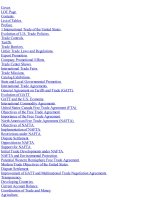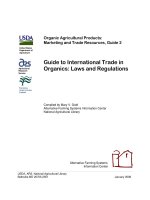America's international trade - a reference handbook (contemporary world issues)
Bạn đang xem bản rút gọn của tài liệu. Xem và tải ngay bản đầy đủ của tài liệu tại đây (1.38 MB, 470 trang )
Cover
LOC Page
Contents
List of Tables
Preface
1 International Trade of the United States
Evolution of U.S. Trade Policies
Trade Controls
Tariffs
Trade Barriers
Unfair Trade Laws and Regulations
Export Promotion
Company Promotional Efforts
Trade Center Shows
International Trade Fairs
Trade Missions
Catalog Exhibitions
State and Local Governmental Promotion
International Trade Agreements
General Agreement on Tariffs and Trade (GATT)
Evolution of GATT
GATT and the U.S. Economy
International Commodity Agreements
United States-Canada Free Trade Agreement (FTA)
Objectives of the Free Trade Agreement
Importance of the Free Trade Agreement
North American Free Trade Agreement (NAFTA)
Objectives of NAFTA
Implementation of NAFTA
Restrictions under NAFTA
Dispute Settlement
Opposition to NAFTA
Support for NAFTA
Initial Trade Developments under NAFTA
NAFTA and Environmental Protection
Potential Western Hemisphere Free Trade Agreement
Modern Trade Objectives of the United States
Dispute Settlement
Improvement of GATT and Multinational Trade Negotiation Agreements
Transparency
Developing Countries
Current Account Balance
Coordination of Trade and Money
Agriculture
Reduction of Unfair Trade Practices
Trade in Services
Intellectual Property
Foreign Direct Investment
Safeguards
Specific Barriers
Workers' Rights
Access to High Technology
Border Taxes
Growth of U.S. International Trade
Importance of International Trade
Balance of Trade
Importance of Exports to State Economies
Commodity Trade
Agricultural Commodities
Manufactured Goods
Minerals
Geographical Distribution of U.S. Trade
United States-Canada Trade Relations
United States-Japan Trade Relations
United States-Mexico Trade Relations
Developing Trade Policies
Trade between Mexico and the United States
Mexican Trade Potential
Future of U.S. International Trade
2 Chronology
U.S. Trade Legislation
Basic Trade Legislation
Tariff Acts
Export Trade Act
Export Enhancement Acts
Customs Acts
Export-Import Bank Acts
Export-Import Bank Amendments
Export-Import Bank of Washington
Export Trading Companies
Merchant Marine Acts
Related Trade Acts
Market and Finance Acts
Coordination Act
Agriculture
Forest
International Trade Agreements
3 Laws and Regulations
Basic Trade Legislation
Tariff Act of 1861
Tariff Act of 1922
Tariff Act of 1930
Trade Expansion Act of 1962
Trade Act of 1974
Trade Agreement Extension Acts
Trade Agreement Act of 1979
Export Trading Company Act of 1982
Trade and Development Enhancement Act of 1983
Trade and Tariff Act of 1984
Omnibus Trade and Competitiveness Act of 1988
Customs and Trade Act of 1990
Specialty Trade Acts
Trading with the Enemy Act of 1917
Export-Import Bank Act of 1945
Export Control Act of 1949
Trade Fair Act of 1959
Export Administration Act of 1969
Other Trade Acts
Tariff Acts
Custom Acts
Export-Import Bank
Export-Import Bank of Washington
Export Trading Company Acts
Merchant Marine Acts
Special Trade Acts
International Trade Laws
United States-Canada Free Trade Agreement Implementation Act of 1988
4 Directory of Organizations
Government Organizations of the United States
U.S. Intergovernmental Advisory Committees
National Organizations
International Organizations
World Trade Centers
Organization Sources
5 Bibliography
Books
General
Trade Policies
Modelling
Export Controls
Environment
Free Trade
GATT
United States-Canada Free Trade Agreement
NAFTA
Russia
Developing World
Iron and Steel Industry
Textiles
Agriculture
Arms
Reference Sources
Dictionaries
Directories
Journal Articles and Government Documents
Trade General
Trade Theory
Models
Trade Competition
Trade Development
Trade Forecasting
Trade Policy
Free Trade
General Agreement on Tariffs and Trade
United States-Canada Free Trade Agreement
North American Free Trade Agreement
Trade Regulations
Trade Barriers
Gray Markets
Labor and International Trade
International Competition
Export-Import Bank
Foreign Exchange
Trade and Environment
Certificates of Origin
Laws and Regulations
Finance
Deficit
Smuggling
Dumping and Antidumping
Temporary Tariff
Countertrade
Countervailing
Marketing Barriers
Cartels
Export Subsidies
Tariffs
Nontariff Trade Barriers
Embargoes
Import Quotas
Trade Promotion
Government Aid
Export Marketing
Commerce
Finance
Assistance
Quality Control
Export Marketing
Trading Companies
Comparative Advantage
Management
Export Processing Zones
Small Business Trade
Commodities
Coffee
High Technology
Textiles
Energy
Motor Vehicles
Glass
Iron and Steel
Agriculture
Communication Equipment Industry
Forest Products
Lumber Industry
Pesticides
Aircraft
Hazardous Material
Chemicals
Apparel
Tobacco
Drugs
Arms
Munitions
Countries and Regions
Asia
China
Japan
Europe
Latin America
Mexico
Soviet Union
Africa
United States
Selected Journal Titles
6 Audio-Visual Aids
Appendix
U.S. International Banks
Glossary
Index
Copyright © 1995 by ABC-CLIO, Inc.
All rights reserved. No part of this publication may be reproduced, stored in a retrieval system, or transmitted, in any form or by any
means, electronic, mechanical, photocopying, recording, or otherwise, except for the inclusion of brief quotations in a review, without prior
permission in writing from the publishers.
Library of Congress Cataloging-in-Publication Data
Miller, E. Willard (Eugene Willard), 1915–
America’s international trade : a reference handbook / E. Willard
Miller, Ruby M. Miller.
p. cm.—(Contemporary world issues)
ISBN 0-87436-770-0 (cloth : alk. paper)
1. United States—Commerce—Handbooks, manuals, etc. 2. United
States—Commercial policy—Handbooks, manuals, etc. 3. Foreign
trade regulation—United States—Handbooks, manuals, etc. 4. United
States—Commerce—Bibliography. I. Miller, Ruby M. II. Title.
III. Series.
HF3035.M55 1995 95-14135
382'.0973—dc20 CIP
02 01 00 99 98 97 96 95 10 9 8 7 6 5 4 3 2 1
ABC-CLIO, Inc.
130 Cremona Drive, P.O. Box 1911
Santa Barbara, California 93116-1911
This book is printed on acid-free paper .
Manufactured in the United States of America
Page v
Contents
List of Tables, xi
Preface, xiii
1 International Trade of the United States, 1
Evolution of U.S. Trade Policies, 1
Trade Controls, 3
Tariffs, 3
Trade Barriers, 4
Unfair Trade Laws and Regulations, 4
Export Promotion, 7
Company Promotional Efforts, 7
Trade Center Shows, 7
International Trade Fairs, 8
Trade Missions, 8
Catalog Exhibitions, 9
State and Local Governmental Promotion, 9
International Trade Agreements, 10
General Agreement on Tariffs and Trade, 10
Page xi
Tables
1. Number of Antidumping and Countervailing Duty Investigations by the United States, 1980–
1989, 6
2. Target Industries of U.S. Antidumping and Countervailing Duty Investigations, 1980–1989, 6
3. U.S. Share of World Trade, 1960–1990, 29
4. U.S. Balance of Trade, 1950–1992, 29
5. U.S. Exports by State of Origin, 1992, 29
6. Commodity Trade and Balance of Payments, 1992, 31
7. Trade in Agricultural Commodities, 1992, 31
8. Trade in Manufactured Goods, 1992, 32
9. Passenger Car Imports, 1965–1990, 33
10. Trade in Minerals, 1992, 33
11. U.S. Imports by Country of Origin, 1985 and 1990, 35
12. U.S. Exports to Countries, 1985–1990, 35
Page xiii
Preface
Throughout much of the history of the United States, the domestic market provided the major outlet for
the national economy. Accordingly, most legislation during this period protected the domestic
economy. After World War II, the traditional policies changed as the United States rebuilt the world’s
economy. To reach the world market, policies of free trade have gradually developed. The United
States is now part of the globalization of the world’s economy. Fundamental changes are evolving as
the United States competes in the world market.
This book begins with a short description of the evolution of the trade policies of the United
States. A discussion of tariffs and trade barriers is followed by an analysis of trade promotion
techniques such as trade fairs, advertising, catalogs, and trade missions. Since World War II, the
development of global policies on trade relationships have become increasingly essential to the
economy of individual nations. Beginning in 1947, the world’s nations have attempted to develop a
global policy, such as the General Agreement on Tariffs and Trade. More recently, free trade policies
have evolved under regional systems. The United States has been a leader in the evolution of free
trade in North America. The trade legislation of the
Page 1
1 International Trade of the United States
Evolution of U.S. Trade Policies
The evolution of the international trade policies of the United States reflects not only the dominance
of the domestic economy but also the relationships that the United States has developed in the world
economy. In the nineteenth century, Congress adopted a protectionist stance to protect the infant
industries, and thus the comprehensive trade legislation of 1860 established tariffs on essentially all
imports.
For nearly three-quarters of a century, the industrialists of the North were protected from foreign
imports. In 1913, Congress attempted to lower the U.S. customs duties, but these changes were
reversed in 1921. Although the United States had become the world’s leading industrial nation, as
well as the world’s principal creditor nation, the protectionist policy persisted. This policy reached a
climax in the Smoot-Hawley Tariff Act of 1930.
The response to this act was a dramatic reduction of world trade. The loss of U.S. exports at the
time of a deep economic recession in the nation deepened the economic problems. Consequently,
Congress enacted the 1934 Reciprocal Trade Agreement, which authorized the president to reduce
existing
Page 3
South Africa, Uruguay, and Chile. U.S. trade embargoes banned exports to Cuba, Vietnam, Rhodesia,
and other countries.
In the 1970s, the export of services increased. Significantly, the importance of such exports grew
as deficits in commodity trade increased. The trade deficit was reduced to some extent by a growing
balance attributed to services. In response to this trend, the U.S. government in 1981 adopted a policy
to promote trade in services, and Congress passed a series of acts toward that end. This response has
become a worldwide trend. For example, in the Uruguay Round of GATT in 1982, services were
identified as significant areas for tariff reductions.
In 1988, Congress enacted legislation, the Omnibus Trade and Competitiveness Act, that
provided a comprehensive policy for the development of American trade. This act provided the
foundation for the initial Canada–United States Free Trade Agreement and the more comprehensive
North America Free Trade Agreement.
Trade Controls
There are two types of trade barriers, tariff and nontariff, that limit trade between nations. Tariff
barriers refer to taxes such as customs duties levied on goods entering a nation. Trade barriers consist
of rules and regulations that control the flow of goods and services to a nation.
Tariffs
Tariffs have been the traditional means of reducing, or even eliminating, international trade. In newly
developing countries, tariffs have frequently been imposed to protect the growth of new industries. In
addition, tariffs have played a role in providing revenues for a nation. There are many types of tariffs.
The simplest and most widely used is the simple tariff, called unilateral, that is imposed on all goods
from all nations. Another type of tariff is known as the general-conventional tariff, which applies to
all nations except those that have tariff treaties or conventions that specify particular conditions.
There is also a specific duty tax, known as an ad valorem duty, that is determined on the basis of a tax
permit, or as a percentage of the value of goods imported.
Since World War II, there has been a worldwide attempt to lower tariffs through GATT. When
the General Agreement on Tariffs and Trade was established in 1947, tariffs worldwide added an
average of almost 40 percent to the price of imported products. In 1987, at the beginning of the
Uruguay Round of GATT, this figure was about 5 percent. When the tariff reduction of the Uruguay
Round tax cuts have been implemented, tariffs and other trade barriers will be reduced
Page 4
further. The Organization for Economic Cooperation and Development estimates that worldwide
trade will lead to a projected gain in economic output of $270 billion by 2002.
Trade Barriers
Nontax barriers include quotas, preferential treatment to domestic producers, antidumping measures,
and subsidies. Quotas impose a limit on the quantity of specified goods that can be imported. Thus the
United States has established quotas for textile imports from specific countries. A quota may be either
directed against a single nation or applied universally. Antidumping measures are designed to prevent
the practice, common among nations that have excess amounts of certain products, of selling those
products at or even below cost in order to develop trade relations with the importing country. Many
nations provide direct subsidies to designated industries to enable them to compete effectively against
imports. In 1980, for example, the U.S. government subsidized certain types of steel in order to
strengthen the nation’s position against imports, particularly from Japan.
Monetary barriers can control exchange rates. There are three commonly used monetary
restrictions. In the first type, blocked currency, imports are eliminated by restricting the availability
of foreign exchange. This measure is usually imposed for specific commodities and may persist for a
specified time. In 1975, for instance, Iran used a currency blockage to eliminate trade with the United
States. The second currency control consists of differential exchange rates. This barrier sets different
rates for converting currencies into foreign monies in order to control the amount of import goods
from a given country. A government may set different rates on different goods to control the flow of a
particular commodity. Finally, a government can set higher conversion rates on goods it does want
imported. This method is rarely used, for it normally receives such bad publicity that the relations
between governments deteriorate.
Trade barriers may be defined in such broad terms that they are difficult to interpret. In a number
of countries, trade barriers are imposed at the direction of the government, as in Cuba, which has
allowed no trade relations with the United States since the Castro regime assumed power over 30
years ago.
Unfair Trade Laws and Regulations
All countries condemn the use of unfair trade laws, but the practice persists. If, however, the United
States believes an unfair trade situation exists, an investigation may be initiated. A special unit of the
Page 7
Export Promotion
In order for companies to sell on a world market, a promotion program is desirable and possibly even
necessary. Promotion promotes awareness in the foreign market as well as interest in purchasing the
given commodity. Promotion includes advertising, personal selling, sales promotion, and publicity.
For a U.S. company, the most inexpensive way to promote a product is through the U.S. Department of
Commerce. The promotion of a product may also originate from state and local governmental
agencies.
Company Promotional Efforts
Many of the largest firms have developed international organizations to sell their products, a trend
encouraged in recent years by the globalization of industry. International companies must develop a
distribution system that entails a complete sales organization, and considerable capital is required to
develop a company’s world marketing system. The motor vehicle industry and modern high
technology are excellent examples of successful world marketing organizations.
Advertising is fundamental to the success of a company’s international competition. Advertising
represents a tangible resource, transferable from one export market to another, and for many
industries, advertising may in fact constitute their sole contact with overseas markets. For an
advertising campaign to succeed, it must provide fundamental information to the buyer and establish
the importance of the product in the potential market.
Advertising is the most cost-effective method for communicating with potential buyers, but in
order for it to work a complete campaign must be devised. The company must not only present its
product in correct detail, but must also be aware of the local economy and culture. An experienced ad
agency in the host country is normally desirable for an effective selling campaign.
The selection of the most appropriate media is a particularly important task. Although ads can be
placed in the usual radio, television, newspaper, and magazine spots, other more specialized media,
such as general trade and market directories, may be more effective venues, for they reach markets
directly. Many business magazines also issue international editions.
Trade Center Shows
The U.S. Department of Commerce has 17 complete trade centers worldwide, located in such major
centers as Paris, Vienna, Frankfurt,
Warsaw, London, Milan, Sydney, Singapore, Tokyo, Taipei, Seoul, and Mexico City. Each city has
about ten trade shows annually to highlight a particular industry with export potential in the country.
The trade shows provide an excellent opportunity to display products, demonstrate quality of goods,
and provide information. In many fairs, contracts are negotiated at the exhibition. The trade shows are
an excellent way to contact potential customers. For a modest fee, the trade center provides
conference and press previews to attract customers.
International Trade Fairs
International trade fairs offer customers the opportunity to examine industrial products firsthand. A
trade fair may be privately or governmentally sponsored. Many fairs specialize in a particular
product, such as the Paris Air Show and the Frankfurt Book Fair. Many fairs are internationally
known, such as the Hanover Fair in Germany, and attract a worldwide audience.
Many U.S. firms exhibit their products at international fairs. The first type is the private trade
fair, sponsored by the U.S. Department of Commerce. An organization may plan an overseas trade fair
and then acquire a certificate from the U.S. Department of Commerce if it meets the necessary
standards.
The second type is the foreign buyer show. The U.S. and foreign commercial services select
leading U.S. trade shows in industries that exhibit a high export potential. Foreign companies are then
invited to attend these fairs.
The third type consists of U.S. pavilions at international trade fairs where products are
displayed. A company or industry may rent a booth in a pavilion to display products. The U.S.
Department of Commerce may arrange these trade fairs in order to provide attractive and functional
exhibits.
The international trade fair requires careful planning and trained personnel to explain the value
of the products shown.
Trade Missions
Trade missions are planned to provide information to major potential importers of U.S. goods. The
trade missions may be developed by individual firms or governmental sponsors. The U.S. Department
of Commerce plans missions to countries throughout the world to introduce U.S. industry and to
provide information to foreign consumers. A trade mission may consist of 5 to 15 members.
Three types of trade missions may be distinguished. The first consists of personnel from the
Department of Commerce who select a
particular product and plan visits to countries where sales potential is greatest. The program is
tailored to the specific needs of each participant. A major function of the mission is for U.S. citizens
to meet with foreign governmental and industrial leaders.
A second type of mission is the state- and industry-organized mission that is government
approved. These missions are created by state development agencies, trade associations, chambers of
commerce, and other export-oriented groups. These groups must follow the guidelines provided by
the U.S. Chamber of Commerce.
Finally, seminar missions promote the sale of a particular product. These seminars have an
educational sales strategy that provides information on sophisticated products and technology.
Catalog Exhibitions
To provide information to foreign buyers, most companies produce catalogs, brochures, and other
graphic materials. This material is usually distributed through U.S. embassies and consulates. Most
catalogs are devoted to a specific product group so that the U.S. industry expert can provide technical
information to the potential buyer. The cost of a catalog exhibition is modest. In recent years, video
cassettes have added a new dimension to this promotional endeavor.
State and Local Governmental Promotion
Many states offer an array of promotional services to companies seeking an international market. In
addition, many states maintain international offices in market areas around the world. These offices
are most numerous in Japan and Western Europe. The state office supplies information about
domestic producers, provides assistance to trade missions, and helps locate potential buyers. In
recent years, states have encouraged foreign buyers to visit them, and the subsequent person-to-person
relationships have aided successful commercial transactions. These promotional endeavors tend to
stimulate new attitudes toward a company’s product. Sales promotion techniques have become a
standard procedure for the selling of U.S. goods. Sales promotion not only increases the sales
potential but builds the morale of the distributors.
To succeed, this promotional program requires a clear definition of the objectives of the
program, precise information about the product, a realistic budget, and a definite plan for
implementing a sales contract once it is made. Moreover, the project manager must not only have
precise information about the way business is conducted in a particular country but also a good
understanding of the broad culture of the nation.
Page 10
International Trade Agreements
After World War II, policymakers devoted much thought to the types of international economic
organizations that should evolve. The international economic structure of the past was clearly
completely inadequate. The isolation of nations created many of the political conditions that fostered
fascism and military aggression. The negotiation to reconstruct the world’s economy began at the
Bretton Woods conference in the United States in 1944. As a response to these meetings, the
International Monetary Fund (IMF) and the World Bank were established. The conference also
recognized that barriers to trade had to be reduced.
General Agreement on Tariffs and Trade (GATT)
In 1947, the United States and 23 other countries met in Geneva to find ways to reduce tariffs and
remove trade barriers. The fundamental principles were established at this meeting. The General
Agreement on Tariffs and Trade stipulated that these 23 countries must treat foreign firms the same as
domestic firms in all trade relationships. Consequently, GATT members agreed to extend to all their
trading partners the concessions awarded to a single nation.
Evolution of GATT
The second meeting of GATT was held at Annecy, France, in 1949. Thirty-three countries
participated in the second meeting. The Geneva and Annecy meetings established procedures to
reduce tariffs and structure the organization.
The Torquay and Geneva Rounds, in 1951 and 1956, respectively, are regarded as less
significant. The U.S. economy was believed to be so powerful that its predominance could never be
threatened. As a consequence, the United States dominated the world’s economy and controlled trade
relationships, bringing great economic benefits to the world and fueling the belief its dominance
would ensure ultimate world peace.
As the dominance of the United States declined in the 1960s, the need for freer trade was once
again recognized. The Dillon Round in 1962 resulted in further reductions of average world tariff
rates. Its goals, however, of an across-the-board 20 percent reduction of tariffs and the settlement of
problems unresolved in the 1950s, especially those involving trade agreements with less-developed
countries, were not met.
Seventy countries participated in the Kennedy Round, sixth in the series of negotiations, and
major progress was accomplished in the









